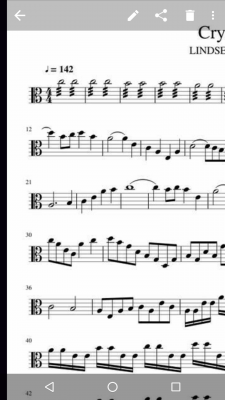Welcome to our forum. A Message To Our New and Prospective Members . Check out our Forum Rules. Lets keep this forum an enjoyable place to visit.
 Topic RSS
Topic RSS



 (0 votes)
(0 votes) Member
 Offline
Offline










Hi @Selflearnerviolinist -
If you mean the actual first scored note, the note itself is a "B" fourth finger on E string - and the slashes through the stem indicates tremolo - check out FiddlerMan's tutorial here -
I assume it's the slashes through the stem that you're curious about ?
Tremolo can mean slightly different things on different instruments and may sometimes involve a change in pitch, alternating between two adjacent notes.
Apparently, the number of "slashes" on the note may give an indication/hint to the player as to the repetition rate, here the 3 slashes would suggest a repetition rate of a demi-semi-quaver or 1/32nd note - although I suspect it's often just interpreted as "play it as fast as possible" given other circumstances ( like bow speed, pressure ).
Having said that, await feedback from others, I'm often on the wrong track myself, but that's how I currently understand it ! LOL
EDIT : ROFL - I would have silently corrected the above but I'll say it here (proves I'm human after all - what a let-down ) - the note is NOT a "B" - hahahaha - the piece is in alto clef - hadn't noticed until I reviewed the post - it's a "C", second finger on the top A string ! Grrrrrrrrrrrrrrrrr  The rest of my comment, I'll leave unchanged. I give up.....
The rest of my comment, I'll leave unchanged. I give up..... 
I seriously recommend not copying my mistakes. D'oh -
Please make your own, different mistakes, and help us all learn :-)
Member
 Offline
OfflineBillyG said
Hi @Selflearnerviolinist -If you mean the actual first scored note, the note itself is a "B" fourth finger on E string - and the slashes through the stem indicates tremolo - check out FiddlerMan's tutorial here -
I assume it's the slashes through the stem that you're curious about ?
Tremolo can mean slightly different things on different instruments and may sometimes involve a change in pitch, alternating between two adjacent notes.
Apparently, the number of "slashes" on the note may give an indication/hint to the player as to the repetition rate, here the 3 slashes would suggest a repetition rate of a demi-semi-quaver or 1/32nd note - although I suspect it's often just interpreted as "play it as fast as possible" given other circumstances ( like bow speed, pressure ).
Having said that, await feedback from others, I'm often on the wrong track myself, but that's how I currently understand it ! LOL
EDIT : ROFL - I would have silently corrected the above but I'll say it here (proves I'm human after all - what a let-down ) - the note is NOT a "B" - hahahaha - the piece is in alto clef - hadn't noticed until I reviewed the post - it's a "C", second finger on the top A string ! Grrrrrrrrrrrrrrrrr
The rest of my comment, I'll leave unchanged. I give up.....

Hi Billy,
Thanks for your help here. It's clear now.
Quick question, how do you know it's a C not the B as i suspected.
Happy Violining!!
Regulars
 Offline
Offline

Because of the definition of an alto clef (see https://en.wikipedia.org/wiki/.....#Alto_clef). The line that the center of the figure at the front is on is C. Count up 8 notes, and you're at the note that's showing at the beginning of that piece, and since it's 8 notes, it's another C.
1 Guest(s)


 Log In
Log In Register
Register











